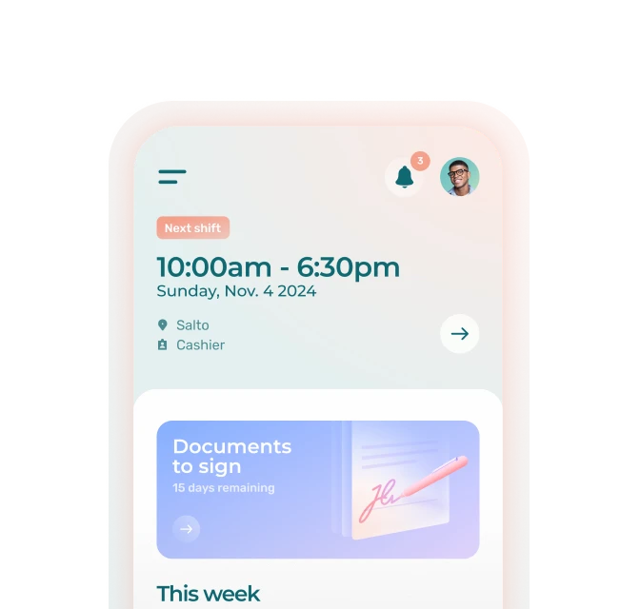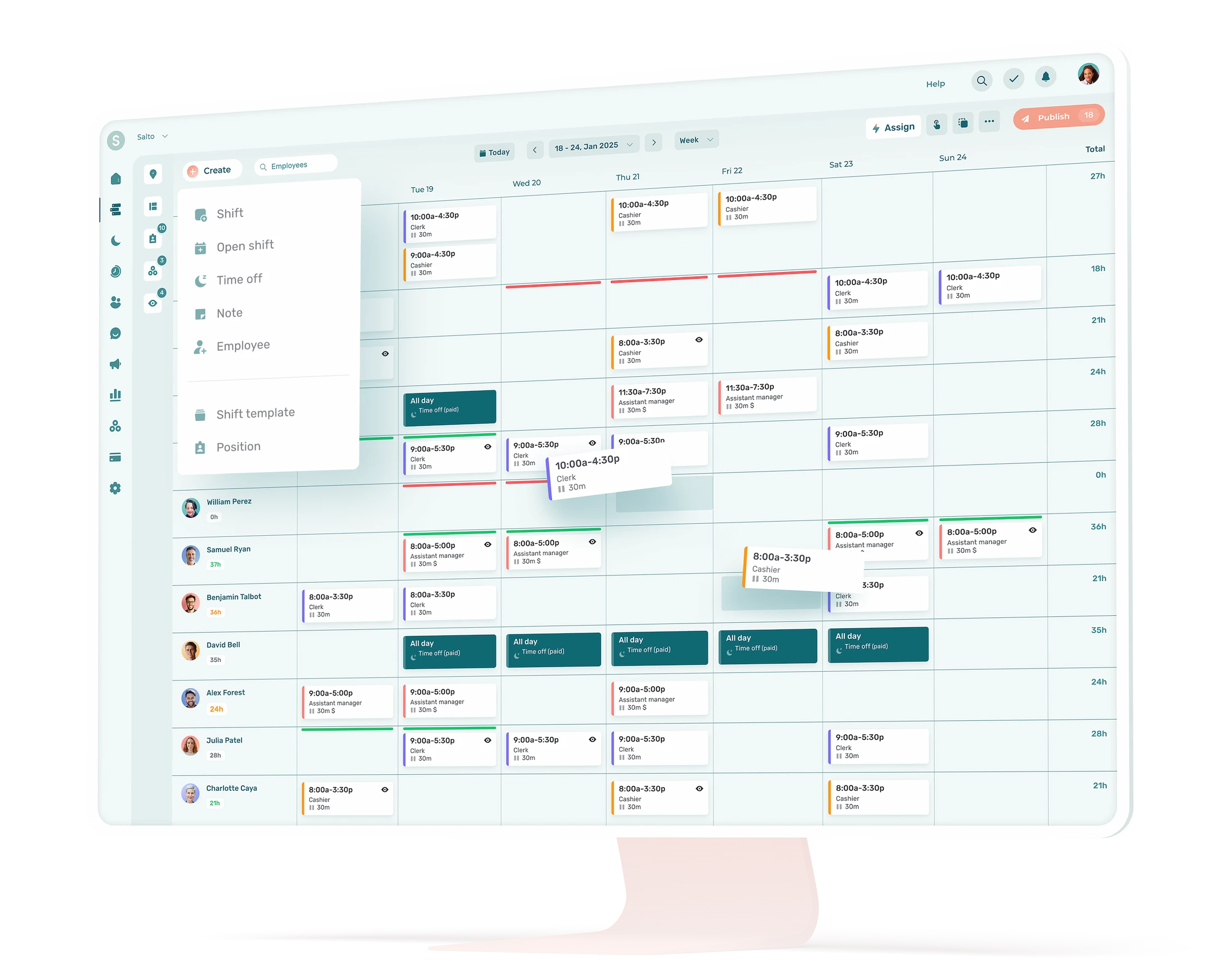Small business managers are often required to wear many hats and handle a wide range of tasks, from human resources management to marketing and even customer service.
Managing human resources requires both flexibility and adaptability, as well as structure and organization.
Your employees are your most valuable asset. It’s essential to protect them and nurture your relationship with them to ensure a thriving, high-performing business.
The following article will help you understand the importance of good HR management in your small business and what steps you can take to achieve it.
HR Management: Definition, Tasks, Goals, and Benefits
HR management refers to the processes, methods, and policies implemented within a company to manage employees.
HR management includes all tasks related to managing employees, such as:
- Creating and managing schedules
- Developing internal policies
- Ensuring compliance with employment laws
- Recruiting and onboarding new employees
- Developing skills strategies
- Providing training
- Establishing compensation policies
- Managing performance
- Managing conflict
- Facilitating internal communication
- Implementing health, safety, and well-being policies
- Offboarding employees
- And more
The main goal of HR management is to ensure that business activities are supported by a qualified, motivated, and competent team to guarantee the organization’s success.
HR management also aims to:
- Attract and recruit talent
- Develop employee skills
- Motivate and retain employees
- Ensure legal compliance in company practices
- Promote a healthy work environment
- Ensure health, safety, and well-being at work
- Align HR management with the company’s strategy
The Benefits of Good HR Management
Implementing good HR management practices should be a priority for all businesses.
The benefits of having strong HR management include:
- Setting the tone for company culture
- Ensuring legal compliance of company policies
- Improving employee performance and productivity
- Reducing employee turnover
- Ensuring business success
- Motivating and retaining employees
- Reducing personnel-related costs
- Fostering innovation and competitiveness
Best HR Practices for Small Businesses
Human resources management is essential as it impacts the most important resource in your business—your people. It is even more critical in small businesses, where teams are small and must collaborate daily.
Small business managers are often required to wear multiple hats and handle a variety of tasks, from employee management to marketing and customer service.
This is why implementing HR practices that simplify work organization and ensure operational success is crucial.
Here are the 10 best HR practices to implement in your SMB.
1. Secure Employee Records
Employee personal data should be kept in a secure location, whether in a locked filing cabinet or an online software system.
Securing and centralizing employee records makes it easier to access all their information in one place, making it easier to track performance evaluations and document disciplinary actions.
2. Create an Employee Handbook
When you think of an employee handbook, large companies often come to mind. However, small businesses can also benefit from having one, to clarify the rules and policies, helping to avoid potential disputes.
The handbook can be relatively simple if you have a small team, or it can be more detailed based on your needs.
Here’s what an employee handbook should generally include:
- The company’s mission, vision, and values
- Internal policies: dress code, working hours, leave requests, benefits, compensation policy, code of conduct, communication methods, or any other relevant information
- The company structure (hierarchy and key personnel)
The employee handbook should be accessible at all times. Ensure that new employees read it and fully understand its content. You can even ask them to return a signed and dated copy.
💡 Agendrix’s HRIS software allows you to request electronic signatures from your employees when sharing documents with them.
3. Have a Well-Established Recruitment Process
An effective recruitment process is a valuable asset for SMBs, where high employee turnover can be costly.
To achieve this, clearly define the skills you need before starting the recruitment process. This will help you identify candidates with the most suitable and relevant profiles for your team.
Also, use the right recruitment platforms for your industry, whether it’s LinkedIn, social media, or specialized websites. Avoid putting candidates through multiple rounds of interviews. Share your decision as soon as possible to keep them engaged and motivated.
4. Create Job Descriptions
Many SMBs skip the step of creating job descriptions for employees. However, this is a best practice that helps better manage the company’s resources.
Job descriptions help employees better understand what is expected of them, as well as their roles and responsibilities. It also becomes easier for managers to optimize task organization and create optimal work schedules.
Detailed job descriptions are also valuable tools as the business grows, making it easier to anticipate workforce needs.
5. Conduct Regular Performance Evaluations
Most companies only conduct performance evaluations once a year. You should aim for 2 to 4 evaluations annually.
With this frequency, you can address issues more quickly and set new goals to keep employees motivated and engaged.
These meetings also allow you to identify strengths and areas for improvement in your employees, enabling you to create personalized training plans and help them develop their skills.
Wondering how to encourage skill development? This article will teach you everything you need to know!
6. Providing Feedback to Your Employees
Providing regular feedback helps improve motivation, performance, and collaboration within a team. This is an important practice in any business, but especially in small ones where employees and managers interact daily.
Giving feedback to your employees helps them better understand what they are doing well and what they need to improve. Recognizing good work strengthens employee motivation and confidence while boosting their sense of belonging to your company.
To recognize your employees’ good work, you can:
- Implement an Employee of the Month program
- Mention your employees’ achievements during team meetings
- Take the time to thank them more often
- Offer performance bonuses
- Provide longer breaks during busy periods
See our article on strategies for providing constructive feedback to learn how to offer feedback effectively.
7. Create an Engaging Company Culture
When your team is small, it’s important to build strong connections with them and create an engaging company culture to retain and motivate them. Be transparent with your employees to build trust and foster better team synergy.
Don’t hesitate to show your trust in them by assigning interesting and important tasks. You can also organize team-building activities to strengthen bonds outside the more rigid work setting.
Offer them attractive working conditions to differentiate yourself from other employers. Here are some examples:
- Flexible working hours
- Competitive salary
- Employee discounts
- RRSP contributions
- Group insurance
- Extra day off on their birthday
- Free snacks and drinks during breaks
8. Foster Open and Transparent Communication
In a small business, the team is naturally smaller and interacts more frequently. It’s crucial to maintain open and transparent communication to boost productivity and employee engagement.
Sharing information clearly ensures that everyone is on the same page and holds employees accountable. Open communication also helps reduce conflicts and creates a healthy work environment.
Here are some tips for implementing open and transparent communication in your business:
- Use the right communication channels: avoid social media for communicating with employees and opt for professional tools like employee management software (e.g., Agendrix).
- Explain your decisions and ask for your employees’ input.
- Hold regular team meetings.
- Share company results and challenges honestly.
9. Implement a Training and Skill Development Program
It’s important to invest in the training and skill development of your employees, especially if you have a small business. This ensures the growth of the organization and helps prevent a high employee turnover rate.
If you’re not sure where to start, ask your employees directly which skills they’d like to develop and help them achieve their goal.
A solid training program will also help attract new talent as your needs grow.
Examples of training to offer:
- Training for software tools (employee management software, Excel, Google Workspace, inventory management software, etc.)
- Point of sale (POS) system training
- Teamwork & communication training
- Sales and customer relations training
- Leadership and team management training
- Recruitment and employee onboarding training
10. Offer Flexibility to Your Employees
Offering flexibility at work promotes a better work-life balance. As a SMB, you benefit from implementing measures that allow your employees to thrive both at work and at home, helping to retain them.
Workplace flexibility also boosts motivation and employee engagement. It demonstrates trust in your team and shows you care about their well-being.
Examples of flexibility measures for your business:
- Offer flexible hours: such as variable schedules or rotating shifts
- Allow shift swaps
- Make it easier to take time off
- Provide longer breaks
- Allow unpaid leave
Manage Human Resources with the Right Tools
Agendrix HRIS Software
Using a HRIS sofware (or an employee management software) like Agendrix is a valuable asset for small business managers. It centralizes HR tasks, saving time and boosting efficiency.
This allows managers to focus on what really matters: their employees.
Working with high-performing tools enables greater productivity and improves processes to help achieve your goals faster. It’s crucial to implement effective strategies from the outset to ensure your business’s success.
Agendrix will streamline your management tasks, while securing your employees’ data and ensuring compliance with current labor laws through customizable settings.
The HR features offered in Agendrix software include:
- Centralized employee records online
- Timesheet automation
- Schedule planning
- Employee onboarding and integration module
- HR document management
- Electronic signatures
- Employee surveys
- Work recognition with the High Fives module
What is the Role of Human Resources in a Company?
Human resources (HR) play a crucial role in the smooth operation and success of a business. Their primary mission is to manage human capital, meaning attracting, developing, and retaining talent while ensuring an efficient and healthy work environment.
Why is HR Management Important for SMBs?
HR management is critical for small businesses, as employees are their most valuable resource. Without them, the company’s operations would come to a halt.
Each person plays a key role in a small business. Effective HR management is necessary to ensure employee productivity, performance, and motivation.
How Can Small Businesses Stand Out from Large Ones with Good HR Practices?
Small businesses may not have the same resources as large ones, but they can offer a more human, flexible, and engaging employee experience.
By adopting relevant and personalized HR practices, they can differentiate themselves and attract talent looking for a unique work environment.
What Are the HR Responsibilities in a Company?
HR responsibilities in a company include:
- Recruiting and onboarding new employees
- Managing administrative tasks (employment contracts, legal obligations, payroll management)
- Creating and managing work schedules
- Managing employee records
- Training and developing skills
- Managing performance
- Managing conflicts
- Cultivating company culture
- And more.











